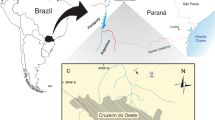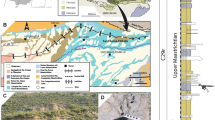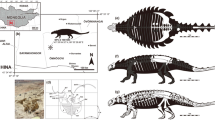Abstract
Carcharodontosaurs were the largest predatory dinosaurs, and their early evolutionary history seems to be more intricate than was previously thought. Until recently, carcharodontosaurs were restricted to a group of large theropods inhabiting the Late Cretaceous Gondwanan land masses1,2, but in the last few years Laurasian evidence3,4,5 has been causing a reevaluation of their initial diversification6. Here we describe an almost complete and exquisitely preserved skeleton of a medium-sized (roughly six metres long) theropod from the Lower Cretaceous series (Barremian stage) Konservat-Lagerstätte of Las Hoyas7 in Cuenca, Spain. Cladistic analysis supports the idea that the new taxon Concavenator corcovatus is a primitive member of Carcharodontosauria6, exhibiting two unusual features: elongation of the neurapophyses of two presacral vertebrae forming a pointed, hump-like structure and a series of small bumps on the ulna. We think that these bumps are homologous to quill knobs present on some modern birds; the knobs are related to the insertion area of follicular ligaments that anchor the roots of the flight feathers (remiges) to the arm. We propose that Concavenator has integumentary follicular structures inserted on the ulna, as in modern birds. Because scales do not have follicles, we consider the structures anchored to the Concavenator arms to be non-scale skin appendages homologous to the feathers of modern birds. If this is true, then the phylogenetic bracket for the presence of non-scale skin structures homologous to feathers in theropod dinosaurs would be extended to the Neotetanurae, enlarging the scope for explaining the origin of feathers in theropods.
This is a preview of subscription content, access via your institution
Access options
Subscribe to this journal
Receive 51 print issues and online access
$199.00 per year
only $3.90 per issue
Buy this article
- Purchase on Springer Link
- Instant access to full article PDF
Prices may be subject to local taxes which are calculated during checkout




Similar content being viewed by others
References
Currie, P. J. & Carpenter, K. A new specimen of Acrocanthosaurus atokensis (Theropoda, Dinosauria) from the Lower Cretaceous Antlers Formation (Lower Cretaceous, Aptian) of Oklahoma, USA. Geodiversitas 22, 207–246 (2000)
Novas, F. E., de Valais, S., Vickers-Rich, P. & Rich, T. A large Cretaceous theropod from Patagonia, Argentina, and the evolution of carcharodontosaurids. Naturwissenschaften 92, 226–230 (2005)
Brusatte, S. L. & Sereno, P. C. Phylogeny of Allosauroidea (Dinosauria: Theropoda): comparative analysis and resolution. J. Syst. Paleontol. 6, 155–182 (2008)
Brusatte, S. L., Benson, R. B. J. & Hutt, S. The osteology of Neovenator salerii (Dinosauria: Theropoda) from the Wealden Group (Barremian) of the Isle of Wight. Monogr. Palaeontogr. Soc. 162, 1–75 (2008)
Brusatte, S. L. et al. The first definitive carcharodontosaurid (Dinosauria: Theropoda) from Asia and the delayed ascent of tyrannosaurids. Naturwissenschaften 96, 1051–1058 (2009)
Benson, R. B. J., Carrano, M. T. & Brusatte, S. L. A new clade of archaic large-bodied predatory dinosaurs (Theropoda: Allosauroidea) that survived to the latest Mesozoic. Naturwissenschaften 97, 71–78 (2010)
Sanz, J. L., Fregenal-Martínez, M. A., Meléndez, N. & Ortega, F. in Paleobiology II (eds Briggs, D. E. G. & Crowther, P. R.) 356–359 (Blackwell Science, 2001)
Holtz, T. R., Jr, Molnar, R. E. & Currie, P. J. in The Dinosauria 2nd edn (eds Weishampel, D. B., Dodson, P. & Osmólska, H.) 71–110 (Univ. of California Press, 2004)
Carrano, M. T. & Sampson, S. D. The phylogeny of Ceratosauria (Dinosauria: Theropoda). J. Syst. Paleontol. 6, 183–236 (2008)
Sereno, P. C. & Brusatte, S. L. Basal abelisaurid and carcharodontosaurid theropods from the Lower Cretaceous Elrhaz Formation of Niger. Acta Palaeontol. Pol. 53, 15–46 (2008)
Turner, A. H., Makovicky, P. J. & Norell, M. A. Feather quill knobs in the dinosaur Velociraptor . Science 317, 1721 (2007)
Holtz, T. R., Jr in The Dinosauria 2nd edn (eds Weishampel, D. B., Dodson, P. & Osmólska, H.) 111–136 (University of California Press, 2004)
Madsen, J. H. Allosaurus fragilis: a revised osteology. Utah Geol. Mineral. Surv. Bull. 109, 1–163 (1976)
Coria, R. A. & Salgado, L. A new giant carnivorous dinosaur from the Cretaceous of Patagonia. Nature 377, 224–226 (1995)
Coria, R. A. & Currie, P. J. A new carcharodontosaurid (Dinosauria, Theropoda) from the Upper Cretaceous of Argentina. Geodiversitas 28, 71–118 (2006)
Chuong, C.-M., Chodankar, R., Widelitz, R. B. & Jiang, T.-X. Evo-Devo of feathers and scales: building complex epithelial appendages. Curr. Opin. Genet. Dev. 10, 449–456 (2000)
Chuong, C. -M. et al. Adaptation to the sky: defining the feather with integument fossils from Mesozoic China and experimental evidences from molecular laboratories. J. Exp. Zool. B 298, 42–56 (2003)
Sawyer, R. H. & Knapp, L. W. Avian skin development and the evolutionary origin of feathers. J. Exp. Zool. B 298, 57–72 (2003)
Taquet, P. Géologie et Paléontologie du Gisement de Gadoufaoua (Aptien du Niger) Cahiers de Paléontologie, CNRS, 1976)
Norman, D. B. On the anatomy of Iguanodon atherfieldensis (Ornithischia: Ornithopoda). Bull. Inst. R. Sci. Nat. Belg. Sci. Terre 56, 281–372 (1986)
Paul, G. S. in Horns and Beaks: Ceratopsian and Ornithopod Dinosaurs (ed. Carpenter, K.) 69–77 (Indiana University Press, 2007)
Brown, B. A new trachodont dinosaur, Hypacrosaurus, from the Edmonton Cretaceous of Alberta. Bull. Am. Mus. Nat. Hist 32, 395–406 (1913)
Stromer, E. Wirbeltier-Reste der Baharije-Stufe (unterstes Cenoman). 3. Das Original des Theropoden Spinosaurus aegyptiacus nov. gen. Abh. K. Bayer. Akad. Wiss. Mathematisch-physikalische Klasse Abhandlung 28, 1–32 (1915)
Sereno, P. C. et al. A long-snouted predatory dinosaur from Africa and the evolution of spinosauroids. Science 282, 1298–1302 (1998)
Stovall, J. W. & Langston, W., Jr Acrocanthosaurus atokensis, a new genus and species of Lower Cretaceous Theropoda from Oklahoma. Am. Midl. Nat. 43, 696–728 (1950)
Olshevsky, G. A revision of the parainfraclass Archosauria Cope, 1869, excluding the advanced Crocodylia. Mesozoic Meanderings 2, 1–196 (1991)
Bailey, J. B. Neural spine elongation in dinosaurs: sailbacks or buffalo-backs? J. Paleontol. 71, 1124–1146 (1997)
Zheng, X.-T., You, H., Xing, X. & Dong, Z. An Early Cretaceous heterodontosaurid dinosaur with filamentous integumentary structures. Nature 458, 333–336 (2009)
Mayr, G., Peters, D. S., Plodowski, G. & Vogel, O. Bristle-like integumentary structures at the tail of the horned dinosaur Psittacosaurus . Naturwissenschaften 89, 361–365 (2002)
Alibardi, L. & Toni, M. Cytochemical and molecular characteristics of the process of cornification during feather morphogenesis. Prog. Histochem. Cytochem. 43, 1–69 (2008)
Acknowledgements
We thank S. Prieto for information about the location of the specimen; C. Díaz-Romeral, R. de la Fuente, M. García Oliva and N. Santamaría for participating in the field; P. García, M. Llandres, P. Moyano and J. Saiz for specimen preparation; L. Chiappe (Natural History Museum of LA County) for comments on the manuscript; E. Feeman and Plan de Promoción de la Investigación en la Universidad Nacional de Educación a Distancia for manuscript revision; R. Martín for the flesh reconstruction of Concavenator in Fig. 2; and S. Torralba for photography. We acknowledge the Museo de las Ciencias de Castilla-La Mancha for support and funding. Part of this research was financed by project CGL2005-05614 of the Spanish Ministerio de Ciencia e Innovación.
Author information
Authors and Affiliations
Contributions
All authors shared all the phases and topics of the work, both in research and in writing the manuscript. F.O. and F.E. were mainly involved in the description and phylogenetical analysis, whereas J.L.S. was mainly involved in the study of the integumentary evidence. All authors discussed the results and implications and commented on the manuscript at all stages.
Corresponding author
Ethics declarations
Competing interests
The authors declare no competing financial interests.
Supplementary information
Supplementary Information
This file contains Supplementary Information comprising Scores for Concavenator corcovatus, Phylogenetic analysis, Selected measurements for appendicular elements of the holotype specimen, additional references, Supplementary Figures 1-5 with legends and Supplementary Pictures 1-5 with legends. Supplementary Information section 1 was corrected on 05 May 2011. (PDF 16262 kb)
Rights and permissions
About this article
Cite this article
Ortega, F., Escaso, F. & Sanz, J. A bizarre, humped Carcharodontosauria (Theropoda) from the Lower Cretaceous of Spain. Nature 467, 203–206 (2010). https://doi.org/10.1038/nature09181
Received:
Accepted:
Issue Date:
DOI: https://doi.org/10.1038/nature09181
This article is cited by
-
Abundance of large ornithopod dinosaurs in the El Castellar Formation (Hauterivian-Barremian, Lower Cretaceous) of the Peñagolosa sub-basin (Teruel, Spain)
Journal of Iberian Geology (2022)
-
Fast-running theropods tracks from the Early Cretaceous of La Rioja, Spain
Scientific Reports (2021)
-
Heritage Outreach, Fossils, Dinosaurs and Sites: How Locals’ Perception Changes After 10 Years of Actions in Historic Urban Villages (Cuenca, Spain)
Geoheritage (2021)
-
Isolated archosaur teeth from Las Hoyas (Barremian, Cuenca, Spain) and the challenge of discriminating highly convergent teeth
Journal of Iberian Geology (2020)
-
Ceratosaur palaeobiology: new insights on evolution and ecology of the southern rulers
Scientific Reports (2018)
Comments
By submitting a comment you agree to abide by our Terms and Community Guidelines. If you find something abusive or that does not comply with our terms or guidelines please flag it as inappropriate.



